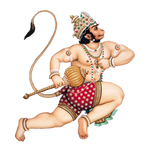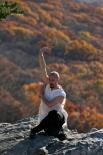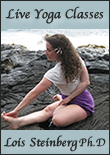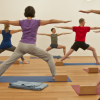Virabhadrasana II
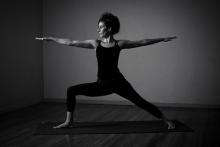
1. From Tadasana, Move into Uttitha Hasta Padasana, and then Parsva Hasta Padasana.
2. Keep the center of the torso vertical and the chest lifted.
3. Extend the arms out to the sides at shoulder height. Extend the elbows, wrists and fingers.
4. Exhale. Bend the right knee. The thigh is parallel to the floor. The knee is in line with the ankle. The shin is perpendicular to the floor.
5. Turn the head to look along the outstretched arm.
6. Come back through Parsva Hasta Padasana, and Utthita Hasta Padasana. Repeat on the left side and return to Tadasana.
This pose strengthens the leg muscles, relieves cramps in the calf and thigh muscles, brings elasticity to the leg and back muscles and tones the abdominal organs.
- Extend through the outer edge of the back heel.
- Press into the inner and outer edges of both feet.
- Do not allow the trunk to lean towards the bent leg while bending the right knee and vice versa.
- Both sides of the trunk should be kept parallel
- While turning the head to the right, do not turn the trunk to the right.
- While doing this pose on the right side, resistance should be created in the left leg.
Use a chair or inflated ball underneath the thigh for support as this is a deep bend of the knee and requires a great deal of strength in the quadriceps.
If the feet slide, place the outer foot on a wall.
- Those who are heavier may find it difficult to the turn the trunk, stretch the spine, or to balance, instead use the support of the wall with either back heel at the wall or standing with the back at the wall and keeping the heels, hips and back of the head on the wall.
- Those suffering from backache, slipped disc, sciatica, lumbago and the elderly should not jump into standing postures, but should do them with the support of the wall.
Teachers' photos of this Asana
|
Daniel Weidenbusch, CIYT |
Are you a Yoga Teacher?
Are you a Yoga Student?
Do you Own a Yoga Studio?
